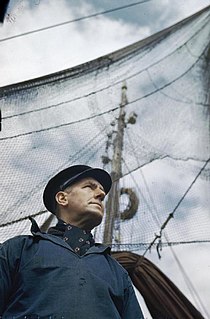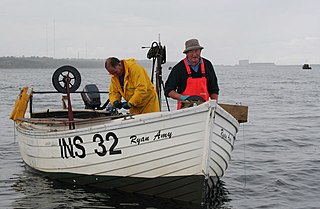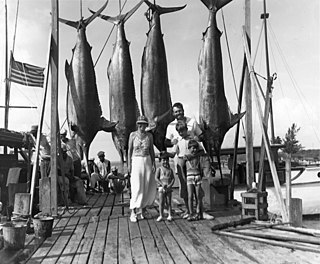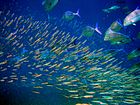
Trolling is a method of fishing where one or more fishing lines, baited with lures or bait fish, are drawn through the water. This may be behind a moving boat, or by slowly winding the line in when fishing from a static position, or even sweeping the line from side-to-side, e.g. when fishing from a jetty. Trolling is used to catch pelagic fish such as salmon, mackerel and kingfish.

Angling is a fishing technique that uses a fish hook or "angle" attached to a fishing line to tether individual fish in the mouth. The fishing line is usually manipulated via a fishing rod, although rodless techniques such as handlining and longlining also exist. Modern angling rods are usually fitted with a reel that functions as a cranking device for storing, retrieving and releasing out the line, although Tenkara fishing and cane pole fishing are two rod-angling methods that do not use any reel. The hook itself can be additionally weighted with a dense tackle called a sinker, and is typically dressed with an appetizing bait to attract the fish and enticing it into swallowing the hook, but sometimes an inedible fake bait with multiple attached hooks is used instead of a single hook with edible bait. A bite indicator, such as a float or a quiver tip, is often used to relay underwater status of the hook to the surface.

A fisher or fisherman is someone who captures fish and other animals from a body of water, or gathers shellfish.
Hemiramphidae is a family of fishes that are commonly called halfbeaks, spipe fish or spipefish. They are a geographically widespread and numerically abundant family of epipelagic fish inhabiting warm waters around the world. The halfbeaks are named for their distinctive jaws, in which the lower jaws are significantly longer than the upper jaws. The similar viviparous halfbeaks have often been included in this family.

Longline fishing, or longlining, is a commercial fishing angling technique that uses a long main line with baited hooks attached at intervals via short branch lines called snoods or gangions. A snood is attached to the main line using a clip or swivel, with the hook at the other end. Longlines are classified mainly by where they are placed in the water column. This can be at the surface or at the bottom. Lines can also be set by means of an anchor, or left to drift. Hundreds or even thousands of baited hooks can hang from a single line.This can lead to many deaths of different marine species Longliners – fishing vessels rigged for longlining – commonly target swordfish, tuna, halibut, sablefish and many other species.

Big-game fishing, also known as offshore sportfishing, offshore gamefishing or blue-water fishing, is a form of recreational fishing targeting large game fish, usually done on a large body of water such as the ocean.

Recreational fishing, also called sport fishing or game fishing, is fishing for leisure, exercise or competition. It can be contrasted with commercial fishing, which is professional fishing for profit; or subsistence fishing, which is fishing for survival and livelihood.

The yellowfin tuna is a species of tuna found in pelagic waters of tropical and subtropical oceans worldwide.

Pelagic fish live in the pelagic zone of ocean or lake waters—being neither close to the bottom nor near the shore—in contrast with demersal fish that do live on or near the bottom, and reef fish that are associated with coral reefs.

Marlin fishing is considered by some game fishermen to be a pinnacle of offshore game fishing, due to the size and power of the four marlin species and their relative rareness. Fishing for marlin captured the imagination of some sport fishermen in the 1930s, when well-known angler/authors Zane Grey, who fished for black, striped, and blue marlin in the Pacific, and Ernest Hemingway, who fished the Florida Keys, Bahamas and Cuba for Atlantic blue marlin and white marlin, wrote extensively about their pursuit and enthused about the sporting qualities of their quarry.

Fish are aquatic, craniate, gill-bearing animals that lack limbs with digits. Included in this definition are the living hagfish, lampreys, and cartilaginous and bony fish as well as various extinct related groups. Approximately 95% of living fish species are ray-finned fish, belonging to the class Actinopterygii, with around 99% of those being teleosts.

In Britain and Ireland, coarse fishing refers to angling for rough fish, which are fish species traditionally considered undesirable as a food or game fish. Freshwater game fish are all salmonids — most particularly salmon, trout and char — so generally coarse fish are freshwater fish that are not salmonids. There is disagreement over whether grayling should be classified as a game fish or a coarse fish.

The little tunny, also known as the false albacore, little tuna, bonita, bonito, or blue bonito, is a species of tuna in the family Scombridae. It can be found in the Atlantic Ocean and the Mediterranean and Black seas; in the western Atlantic, it ranges from Brazil to the New England states. The little tunny is a pelagic fish that can be found regularly in both offshore and inshore waters, and it is classified as a highly migratory species. The little tunny is best identified by the "worm-like" markings on its back and the dark spots appearing between its pectoral and ventral fins.
This page is a list of fishing topics.
This is a glossary of terms used in fisheries, fisheries management and fisheries science.
Land-based game fishing is a form of big-game sport fishing in which anglers attempt to catch oceanic game fish from shore rather than from ocean-going boats. The locations for such activities are generally rock platforms, though wharfs, jetties and beaches are also common. Some species such as sharks can be targeted in shallow littoral water, however most other species prefer deeper pelagic water, and this limits the areas where these types can be fished from the shore. Tackle used is usually comparable to that used on boats, but some differences are necessary, such as changes in rod length. Different tackle is used according to location and species targeted.

Forage fish, also called prey fish or bait fish, are small pelagic fish which are preyed on by larger predators for food. Predators include other larger fish, seabirds and marine mammals. Typical ocean forage fish feed near the base of the food chain on plankton, often by filter feeding. They include particularly fishes of the order Clupeiformes, but also other small fish, including halfbeaks, silversides, smelt such as capelin and goldband fusiliers.

The fishing industry in the Maldives is the island's second main industry. According to national tradition in the words of former President Maumoon Abdul Gayoom, "Fishing is the lifeblood of our nation, it is inborn. From the soil on which we live, to the sea around us, it remains an integral part of our existence. Fishing, and our country and its people, [are] one and shall remain inseparable forever." The Maldives has an abundance of aquatic life and species of fish. Common are tuna, groupers, dolphin fish, barracuda, rainbow runner, trevally and squirrelfish and many more. Aside from being of essential importance to the economy, fishing is also a popular recreational activity in the Maldives, not only among locals but by tourists. The islands have numerous fishing resorts which cater for these activities.

A bait ball, or baitball, occurs when small fish swarm in a tightly packed spherical formation about a common centre. It is a last-ditch defensive measure adopted by small schooling fish when they are threatened by predators. Small schooling fish are eaten by many types of predators, and for this reason they are called bait fish or forage fish.
The following outline is provided as an overview of and topical guide to fish:

















